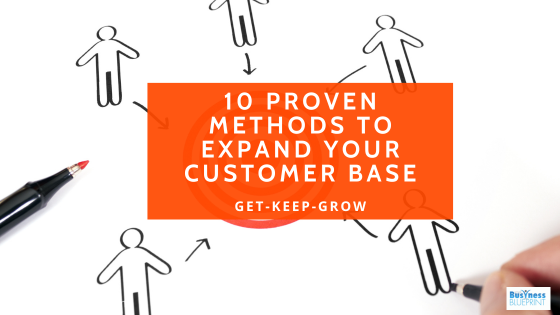Growing your customer base is a fundamental goal for any business.
A larger customer base translates into increased revenue and enhances your brand’s presence and stability in the market.

This article will delve into ten actionable strategies to help you achieve this crucial objective.
From leveraging online marketing to harnessing the power of referrals, these strategies are designed to guide small and medium-sized business owners in their quest for customer expansion.
#1 Leverage Online Marketing:
In today’s digital age, online marketing is a game-changer.
Harness the power of social media, search engine optimisation (SEO), and pay-per-click (PPC) advertising to reach a broader audience.
With the right strategies, your business can tap into the vast potential of online platforms to attract new customers.
Tip 1: Identify Your Target Audience:
Define your ideal customer. Understand their demographics, interests, and online behaviour. This knowledge will help you tailor your online marketing efforts more effectively.
Tip 2: Create Quality Content:
Consistently produce high-quality content that resonates with your audience. Invest in engaging visuals, informative articles, and interactive posts to capture and maintain their attention.
Tip 3: Analyze and Adjust:
Regularly analyse the performance of your online marketing campaigns. Use tools like Google Analytics and social media insights to track key metrics. Adjust your strategies based on what works best for your audience.
#2 Harness the Power of Referral Programs:
Word-of-mouth recommendations have always been powerful. Encourage your existing customers to refer your business to their friends and family by offering incentives.
This approach rewards loyal customers and expands your customer network through trusted recommendations.
Tip 1: Offer Irresistible Incentives:
Make your referral program enticing by offering rewards that motivate your customers to refer others. Consider discounts, freebies, or exclusive access to new products.
Tip 2: Make It Easy to Refer:
Simplify the referral process. Provide customers with easy-to-share referral links, pre-written messages, or shareable graphics that they can effortlessly send to their network.
Tip 3: Express Gratitude:
Show appreciation to customers who refer others. Send personalised thank-you messages or exclusive thank-you gifts to foster a strong sense of loyalty.
#3 Networking for Growth:
Don’t underestimate the power of in-person networking and industry events. Meeting potential customers and building relationships can open new opportunities and customers.
Attend relevant conferences and local business gatherings to make connections that matter.
Tip 1: Set Clear Networking Goals:
Before attending an event, define what you want to achieve. Are you looking for potential customers, partners, or industry insights? Having clear goals will guide your interactions.
Tip 2: Build Meaningful Relationships:
Focus on building genuine relationships rather than just collecting business cards. Take the time to understand others’ needs and how you can mutually benefit each other.
Tip 3: Follow Up Promptly:
After an event, follow up with the contacts you made. Send personalised messages or invitations to connect on LinkedIn to keep the conversation going and solidify the relationship.

#4 Content Marketing Insights:
Creating valuable content is a strategic way to attract potential customers. By sharing your expertise through blog posts, videos, or podcasts, you establish yourself as an authority in your industry.
This can pique the interest of potential customers seeking information and solutions.
Tip 1: Solve Problems:
Address common challenges, or pain points your target audience faces. Create content that offers practical solutions and actionable advice.
Tip 2: Consistency is Key:
Maintain a consistent publishing schedule to keep your audience engaged. Regularly update your blog, social media, or YouTube channel with fresh content.
Tip 3: Use Data for Ideas:
Analyse which content performs best among your audience. Use this data to generate ideas for future content and refine your content strategy.
#5 Partnership Opportunities:
Collaboration with other businesses can be a win-win situation. Partnering with complementary businesses can introduce your products or services to a new audience.
Explore joint promotions and cross-marketing initiatives to expand your customer base.
Tip 1: Identify Complementary Businesses:
Look for businesses that complement your products or services rather than direct competitors. A complementary partnership can open up new customer segments.
Tip 2: Create Mutual Value:
Ensure that partnerships benefit both parties. Collaborate on promotions, events, or content that provide value to both your partner and your shared audience.
Tip 3: Formalize Agreements:
When entering into partnerships, document agreements and expectations clearly. This helps prevent misunderstandings and ensures a smoother collaboration.
#6 Effective Email Marketing:
Building and nurturing an email list is a goldmine for customer growth. Send personalised and engaging content to your subscribers, fostering a loyal customer base.
Email marketing allows you to maintain a direct line of communication and nurture potential customers into loyal ones.
Tip 1: Segment Your Email List:
Divide your email list into segments based on demographics, behaviour, or purchase history. This allows you to send more personalised and relevant content.
Tip 2: Craft Attention-Grabbing Subject Lines:
Your subject line should entice recipients to open your emails. Experiment with different approaches, such as curiosity or urgency, to boost open rates.
Tip 3: Provide Value in Every Email:
Whether it’s informative content, exclusive offers, or useful tips, ensure that each email provides value to your subscribers.

#7 Targeted Advertising:
Data analytics plays a pivotal role in targeting the right audience. Utilise customer data to tailor your advertising efforts to specific demographics, behaviours, and interests.
This precision ensures that your marketing budget is well-spent on potential customers most likely to convert.
Tip 1: Define Your Audience:
Use data and analytics to create detailed customer personas. Tailor your advertising campaigns to target these personas specifically.
Tip 2: A/B Testing:
Experiment with ad creatives, copy, and targeting options. A/B testing helps you identify which elements are most effective in attracting potential customers.
Tip 3: Monitor and Adjust:
Regularly monitor the performance of your advertising campaigns. Adjust your budget, targeting criteria, and ad content based on what drives the best results.
#8 Customer Feedback for Improvement:
Feedback is a valuable resource for enhancing your products and services. Listen to your customers’ needs and preferences and make improvements accordingly.
Satisfied customers are likelier to become advocates and refer new customers to your business.
Tip 1: Encourage Honest Feedback:
Create a comfortable environment for customers to share their thoughts and concerns. Use surveys, feedback forms, and follow-up emails to gather input.
Tip 2: Act on Feedback Promptly:
When you receive feedback, promptly address any issues or suggestions. Let customers know that their input matters.
Tip 3: Communicate Changes:
Inform your customers when you make improvements based on their feedback. This demonstrates that you value their opinions and are committed to enhancing their experience.
#9 Local SEO Strategies:
For brick-and-mortar businesses, optimising your online presence for local search is essential. Ensure your business appears in local search results, directories, and map listings.
This strategy helps potential customers in your vicinity discover your business easily.
Tip 1: Optimize Google My Business:
Claim and optimise your Google My Business listing with accurate information, photos, and customer reviews. This boosts your visibility in local search results.
Tip 2: Local Keyword Optimization:
Use location-specific keywords in your website content and metadata. This helps search engines connect your business with local search queries.
Tip 3: Get Local Citations:
Ensure your business information (name, address, phone number) is consistent across online directories, websites, and social media platforms. This reinforces your local SEO efforts.

#10 Educating Potential Customers:
Building trust and interest begins with educating your audience. Share informative content that addresses their pain points and provides solutions.
An educated customer is more likely to choose your business over competitors.
Tip 1: Understand Their Pain Points:
Research and identify potential customers’ challenges. Tailor your educational content to address these specific pain points.
Tip 2: Create How-To Guides:
Develop detailed how-to guides, tutorials, or webinars that provide step-by-step instructions to solve common problems your audience encounters.
Tip 3: Offer Free Workshops or Webinars:
Host live or recorded workshops and webinars where you share valuable knowledge and engage with your audience directly.
Conclusion:
Increasing your customer base is essential for business growth and success. These ten strategies offer a roadmap to expand your customer network effectively.
From embracing online marketing to harnessing the power of referrals and partnerships, each approach has the potential to drive growth.
FAQs:
Q1: What is the significance of online marketing in increasing customers?
A1: Online marketing leverages digital channels to reach a broader audience, making it a cost-effective and efficient way to attract new customers.
Q2: How can I encourage customers to refer my business?
A2: Incentivize referrals by offering rewards or discounts to customers who refer friends and family.
Q3: Why is customer feedback important for business growth?
A3: Customer feedback helps improve products and services, increasing customer satisfaction and attracting new customers through positive word-of-mouth.
Q4: What is local SEO, and how can it benefit my business?
A4: Local SEO strategies optimise your online presence for local search, making it easier for potential customers in your area to find and choose your business.
Q5: How can I educate potential customers to build trust?
A5: Share informative content that addresses their needs and provides solutions, establishing your business as a trusted source of information.
We encourage you to explore and implement these ideas to achieve customer expansion goals.
Share this Article: If you found this article helpful, share it with your network.
Leave a Comment: Share your thoughts and experiences with us in the comments below.




